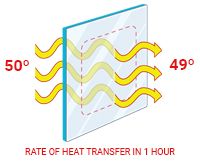

There are basically three forms of heat transfer: radiation, conduction and convection.
It is important to understand the differences between them in order to properly evaluate a project and to explain to the consumer the effects that each type has on a glazing system. The transfer process of solar radiation from the sun to a glass window was discussed in this section’s Solar Radiation page. However, heat can also travel in two other ways through the methods of conduction and convection.
 |
Diagram A: When it is warmer outside, glass will conduct heat towards the inside surface.
Diagram B: Conversely, glass will conduct heat to the outside surface when it is cooler outside.
 Convection – while heat transfer through conduction occurs within a solid material, convection describes the transfer of heat energy in a liquid or gas. When a liquid or gas is heated, it becomes less dense and rises upwards away from the heat source. Subsequently, cooler liquid or gas will take its place and is once again warmed by the heat source and the convection heat transfer process resumes again. An example of this process occurs during the wintertime when a glazing system, warmed by indoor heating units, transfers heat outside the window because convection takes place as the window warms the cooler air. Air movement on the outside picks up heat off the outside glass surface and carries it away.
Convection – while heat transfer through conduction occurs within a solid material, convection describes the transfer of heat energy in a liquid or gas. When a liquid or gas is heated, it becomes less dense and rises upwards away from the heat source. Subsequently, cooler liquid or gas will take its place and is once again warmed by the heat source and the convection heat transfer process resumes again. An example of this process occurs during the wintertime when a glazing system, warmed by indoor heating units, transfers heat outside the window because convection takes place as the window warms the cooler air. Air movement on the outside picks up heat off the outside glass surface and carries it away.

Within the window film and glazing industries, there are several important heat transfer methods used to describe how well a product blocks or transfers solar radiation. The following terms might seem very technical, but they are essential components in understanding heat transfer dynamics.
Solar Heat Gain Coefficient (SHGC) – this is the fraction of solar heat that enters a glazing system and becomes heat. This includes heat directly transmitted as well as heat that is absorbed by the glass and then transmitted inwards. The SHGC measurement is always expressed using a number between 0 and 1. The lower the SHGC, the less heat there is that is being transferred from the exterior to the interior.
 |
U-Value – is a measurement of heat transfer due to outdoor/indoor temperature differences. It's the amount of heat passing through one square foot of glass in one hour for each 1 degree Fahrenheit temperature difference between the indoor and outdoor air. Basically, the lower the U value the less heat energy passes through a window. U values are used primarily by the glazing and window film industries to describe heat loss through glass.
R-Value – Conversely, HVAC engineers and insulation professionals use the R-Value measurement, which describes a material's ability to act as an insulator. The higher the R-Value, the less heat transference. The R-Value is the reciprocal of the U-Value and is expressed as R=1/U-Value.
Emissivity – is used to gauge an object's ability to absorb or reflect radiation.
For example, when the sun's radiant energy passes through glass and enters a room
it strikes various objects (furniture, drapes, rugs, etc.). These objects either absorb the heat energy or "re-radiate" the energy outwards. The lower the emissivity number, the more the material will reflect and not absorb heat. Bright metals, such as gold, silver and aluminum have low emissivity ratings. Conversely, materials such as glass and wood tend to have a higher emissivity number.
The Shading Coefficient (SC) – is basically a comparison analysis between a treated and untreated window. it's the ratio of solar heat gain passing through a glazing system to the solar heat gain that occurs under the same conditions if the window were made of clear, un-shaded window glass. A lower shading coefficient number indicates better solar shading performance.